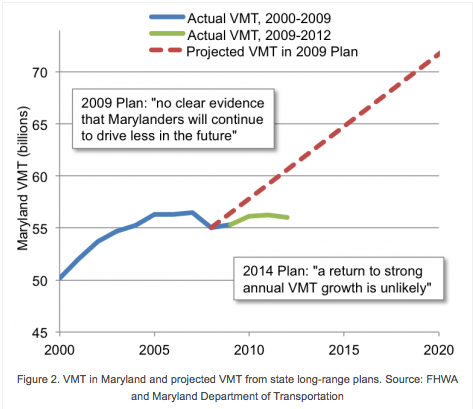
Another year, another decline in per capita driving. For the ninth year in a row, the cumulative distance Americans drive is down, adjusting for population, according to new data from the Federal Highway Administration. Total driving by all Americans has fallen about 2 percent since 2007 -- or 7 percent per capita -- and is lower than it was in 2005.
But a decade of stagnant driving came and went without major adjustments at most state departments of transportation -- the agencies responsible for spending tens of billions of dollars in federal transportation funds each year. The typical state DOT still makes decisions based on models that assume driving will continue to grow forever. The result is billions of dollars spent on unnecessary roads.
But there's some positive news on that front this week. At long last, according to the research team at the State Smart Transportation Initiative, some states are starting to adjust their traffic projections to better reflect reality.
Chris McCahill at SSTI writes:
Maryland is an example of this trend. In 2009, the state’s long-range plan projected statewide VMT [vehicle miles traveled] growth of 2 percent per year through 2030 [pictured above]. The plan dismissed the recent decline as a temporary consequence of high fuel prices and the economic downturn, asserting, “there is no clear evidence that Marylanders will continue to drive less in the future.” However, in its updated plan released just last month, the agency has left out projections entirely, declaring that “a return to strong annual VMT growth is unlikely and per capita VMT [...] is actually decreasing.” A handful of other states have either dampened their projections or shifted their focus toward VMT reduction goals and transportation demand management efforts.
McCahill says most states are still projecting that driving will start rising steadily again soon, despite mounting evidence that the recent decline signifies a long-term trend. But some are starting to see the writing on the wall.
States that have adjusted their traffic projections include Washington and Illinois.
"Washington made a pretty good effort to revise their travel demand model in 2008. Their forecasts have been much better in the time since," said McCahill. "They still predict a little less than 1 percent growth per year."
Illinois, meanwhile, "kind of dampened their projections a little bit," he said. Five years ago the state was predicting traffic would rise 2 percent per year. Now the state is predicting 1 percent annual growth.
Those are the best examples McCahill could offer, after a comprehensive review of state DOTs' long-range plans. And it's worth noting they still assume higher rates of traffic growth than what's been observed in recent years.
Many states, McCahill adds, haven't even updated their long-range plans since driving began to decline almost a decade ago.





